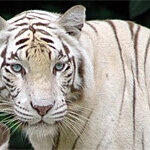Ecology & Zoology

Biologists have found a major clue in a 50-year-old mystery about what happens to green sea turtles after they crawl out of their sandy nests and vanish into the surf, only to reappear several years later relatively close to shore.
Three University of Florida sea turtle scientists say they found the clue by analyzing chemical elements ingrained in the turtles’ shells. Their conclusion: The turtles spend their first three to five “lost years” in the open ocean, feeding on jellyfish and other creatures as carnivores. Only after this period do they move closer to shore and switch to a vegetarian…

If you've ever watched birds at a feeder, you've seen changes in how many birds feed from season to seasons and year to year. Do some of the long-term shifts reflect changes in the environment and climate? To find out, the Cornell Lab of Ornithology's Project FeederWatch is asking bird watchers for help.
FeederWatchers count the birds at their feeders each week and send the information to the lab. They've helped document unusual bird sightings, winter movements and shifting ranges of some bird species over the past 20 years. To see the effects of global climate change, scientists say they…

The sea-ice is getting thinner. Large areas of the Arctic sea-ice are only one metre thick this year, equating to an approximate 50 percent thinning as compared to the year 2001. These are the initial results from the latest Alfred-Wegener-Institute for Polar and Marine Research in the Helmholtz Association lead expedition to the North Polar Sea.
50 scientists have been on board the Research ship- Polarstern for two and a half months, their main aim; to carry out research on the sea-ice areas in the central Arctic. Amongst other things, they have found out that not only the ocean currents…

The fossil record seems to indicate that the diversity of marine creatures increased and decreased over hundreds of millions of years in step with predator-prey encounters, Virginia Tech geoscientists report in the Proceedings of the National Academy of Science.
For decades, there has been a debate between paleontologists, biologists, and ecologists on the role of ecological interactions, such as predation, in the long term patterns of animal evolution.
John Warren Huntley, a postdoctoral scientist in the Department of Geosciences at Virginia Tech, and Geosciences Professor Micha³ Kowalewski…

Bears don't rub trees because their backs are itchy. Dr Owen Nevin of the University of Cumbria states that adult male grizzly bears use so-called “rub trees” as a way to communicate with each other while looking for breeding females, and that this behavior could help reduce battles between the bears.
Many theories have been advanced as to why bears rub trees: some thought females might rub trees as they came into oestrous, and others that bears might be giving their backs a good scratch to get rid of parasites or pick up sap to act as insect repellent. Until now these ideas have been…
Plant biologists at the Max Planck Institute of Developmental Biology and the University of North Carolina at Chapel Hill have discovered that an autoimmune response, triggered by a small number of genes, can be a barrier to producing a viable offspring.
Studying Arabidopsis thaliana, sometimes called thale cress, the researchers identified a phenotype that, when paired together from a male and female, produced plants that survived only long enough to produce a few leaves, then died – a phenomenon called hybrid necrosis; literally, death. The dead plants resembled what would result from a…

How does the Great Barrier Reef work, and coral worldwide? Why do they bleach and die and how will they respond to climate change?
Scientists at the ARC Centre of Excellence for Coral Reef Studies, James Cook University and the University of Queensland have compiled the world’s first detailed gene expression library for Symbiodinium, the microscopic algae that feed the corals – and so provide the primary energy source for the entire Reef.
“Symbiodinium uses sunlight to convert CO2 into carbohydrates for the corals to feed on. At the same time there’s evidence the corals control its output,…

In response to inquiries after a previous blog entry, Macrocosmos and Microcosmos, this article discusses white tiger breeding and their conservational value.
First a quick history: white tigers are very rarely found in the wild. In about 100 years only 12 wild white tigers have been seen in India but they have long been a source of myth. They instill a sense of beauty and awe but folklore calls them an omen of death so while they are idolized by some, they are savagely hunted by others. This was the fate of one tiger, named Mohan, who was captured as a cub in 1951 by a Maharajah and his…

A new poisonous frog was recently discovered in a remote mountainous region in Colombia by a team of young scientists supported by the Conservation Leadership Programme (CLP). The new frog, which is almost two centimetres in length, was given the name the “golden frog of Supatá.”
Originally, the young scientists thought the frog was similar to several other common species in the area. However, after scientific analysis of the frog’s characteristics, and review of their findings by experts at Conservation International, it was determined that the golden frog of Supatá is unique and only found…

Genetically modified wheat hasn’t yet been introduced into the U.S. market. When that happens, public acceptance of the product may depend on what people know about it. Currently, they don’t know much.
A Food Safety Consortium survey conducted by Kansas State University indicated that most respondents had little to no prior knowledge about biotechnology, but about the same number of people said they would still purchase genetically modified (GM) wheat products. But when provided information about opposition to GM products, respondents were more likely to refrain from buying GM products.
“GM…